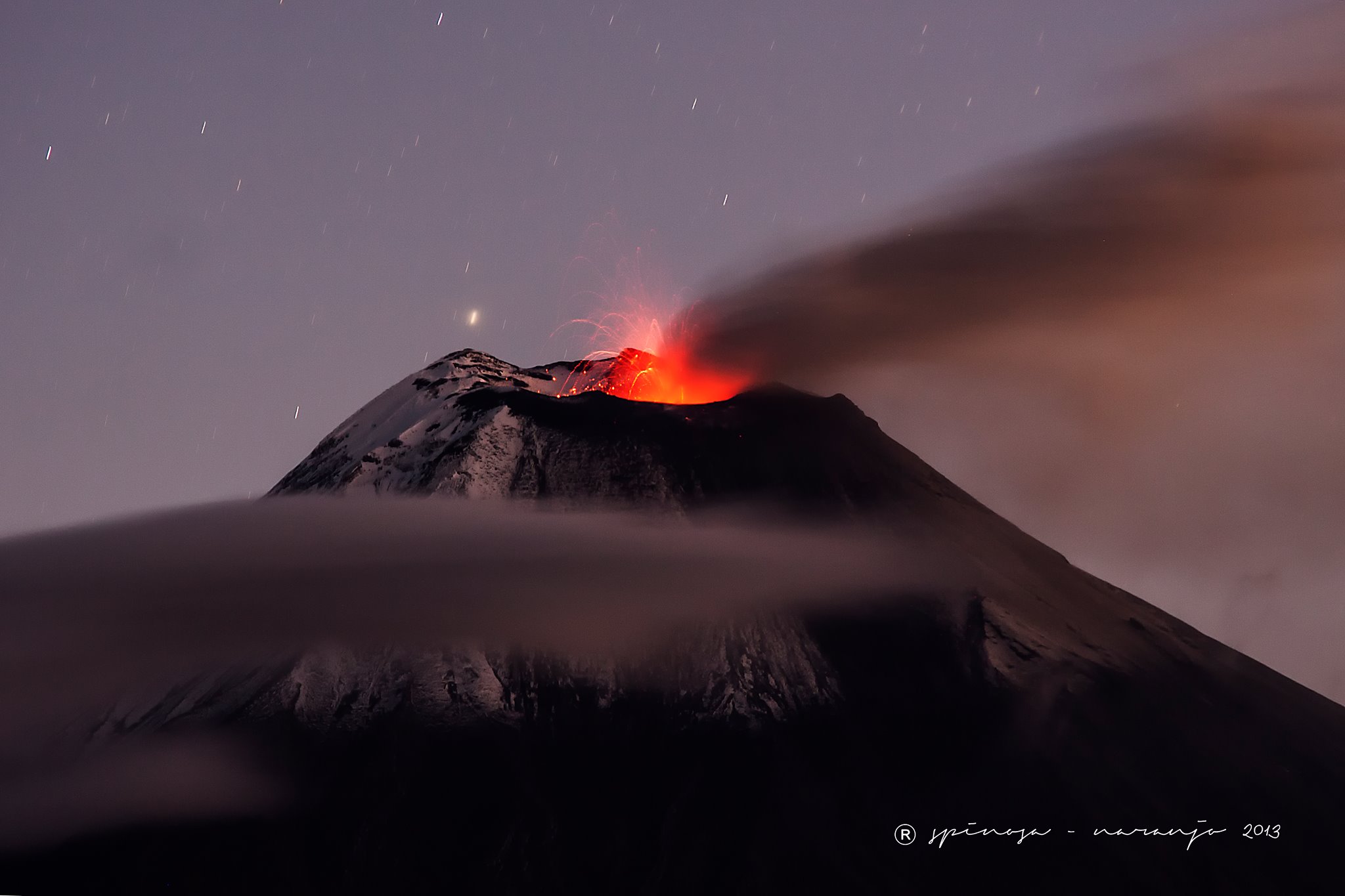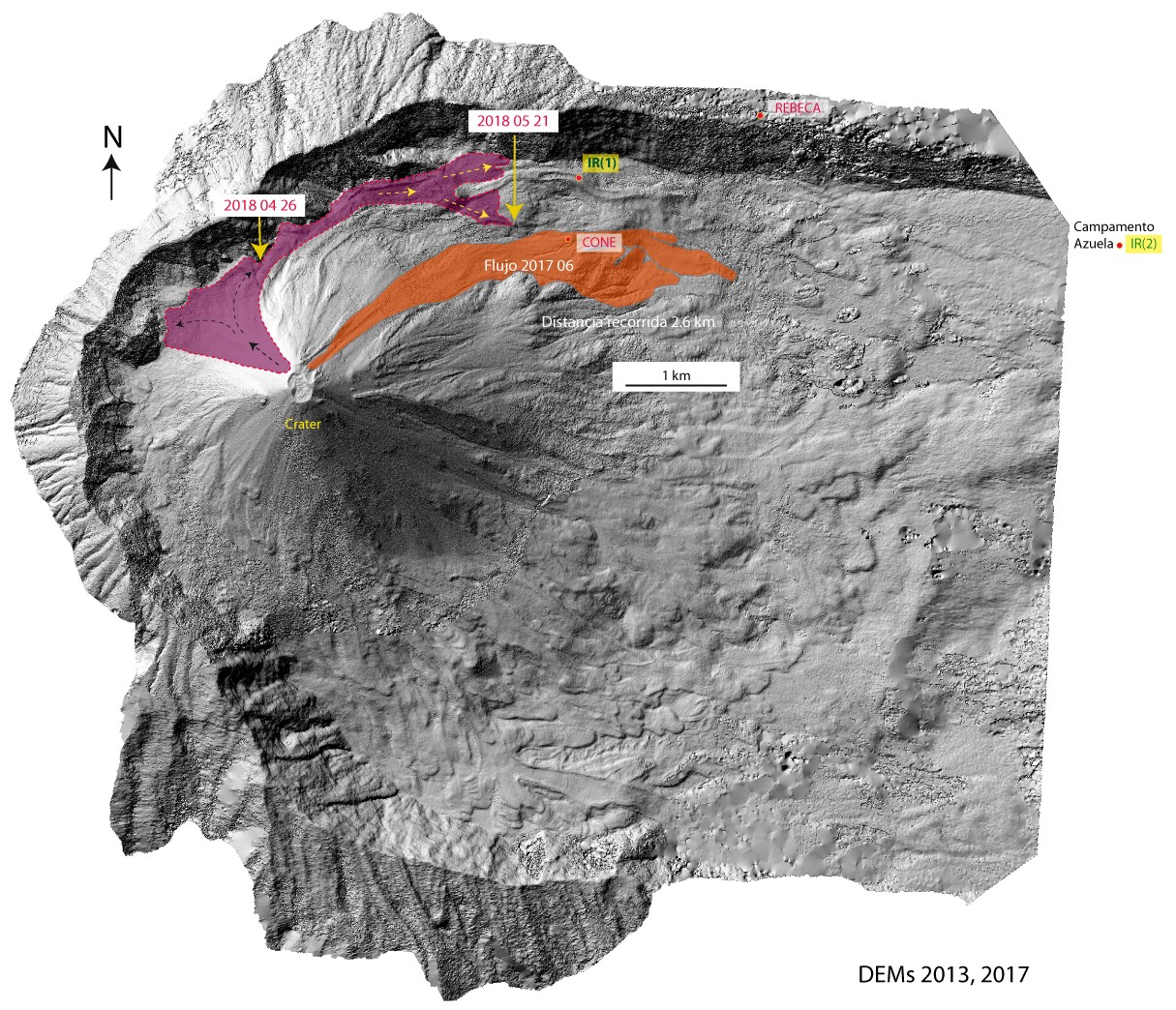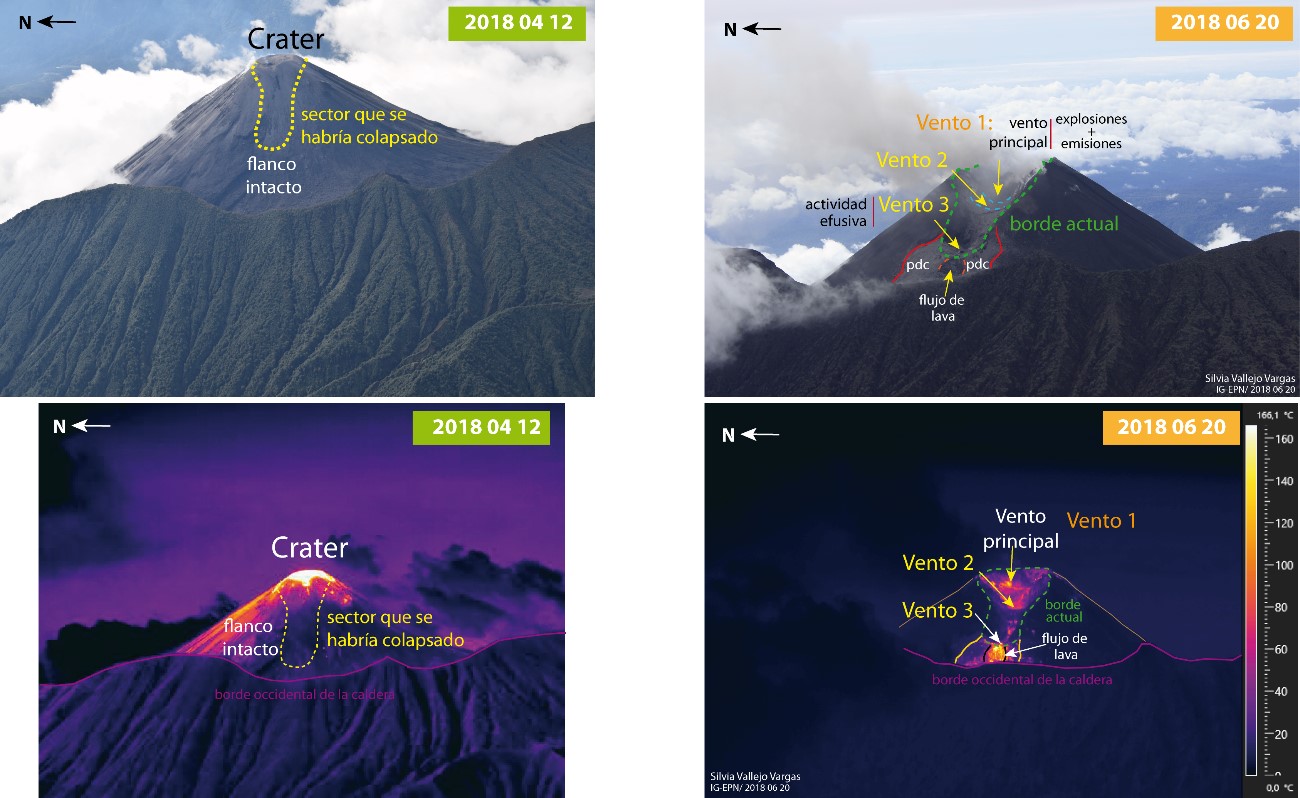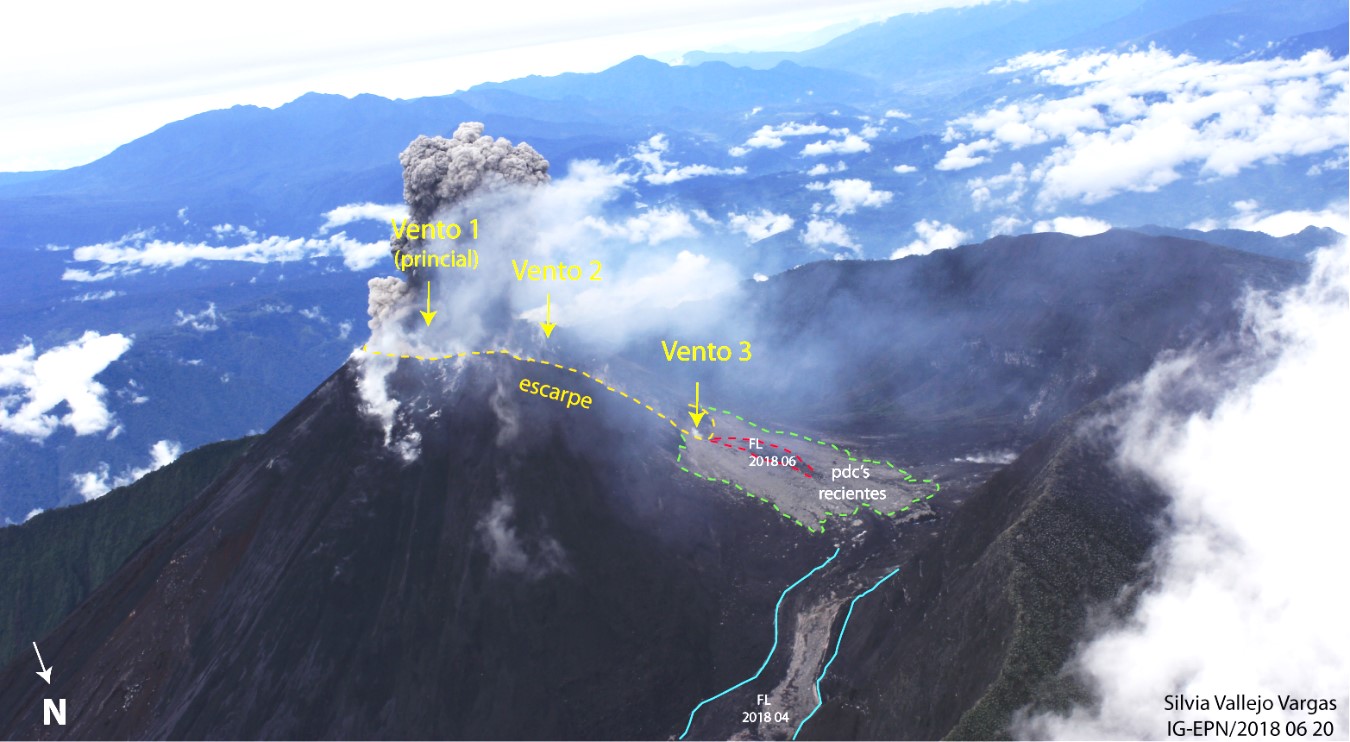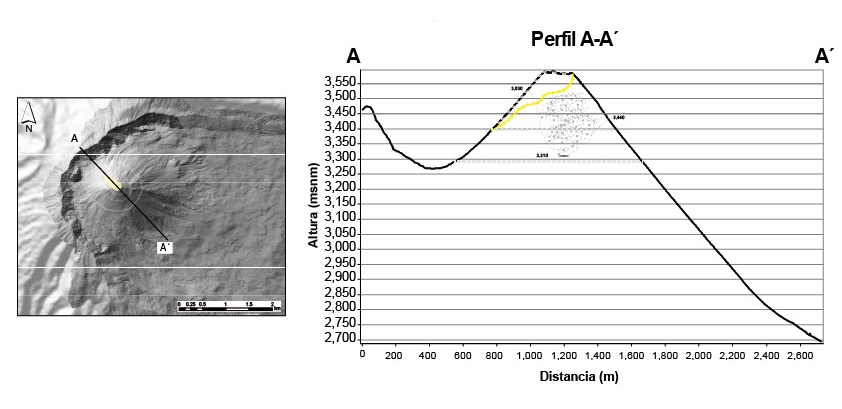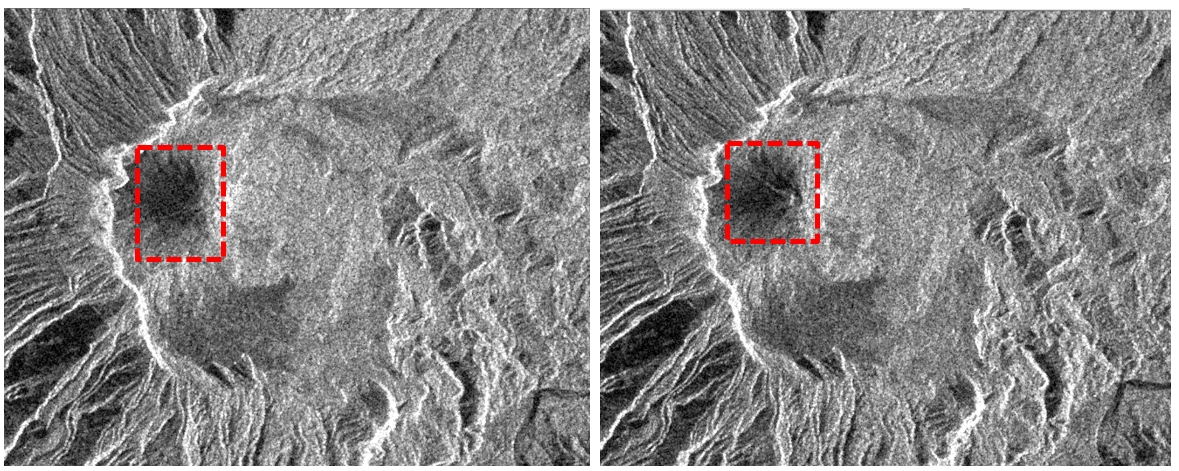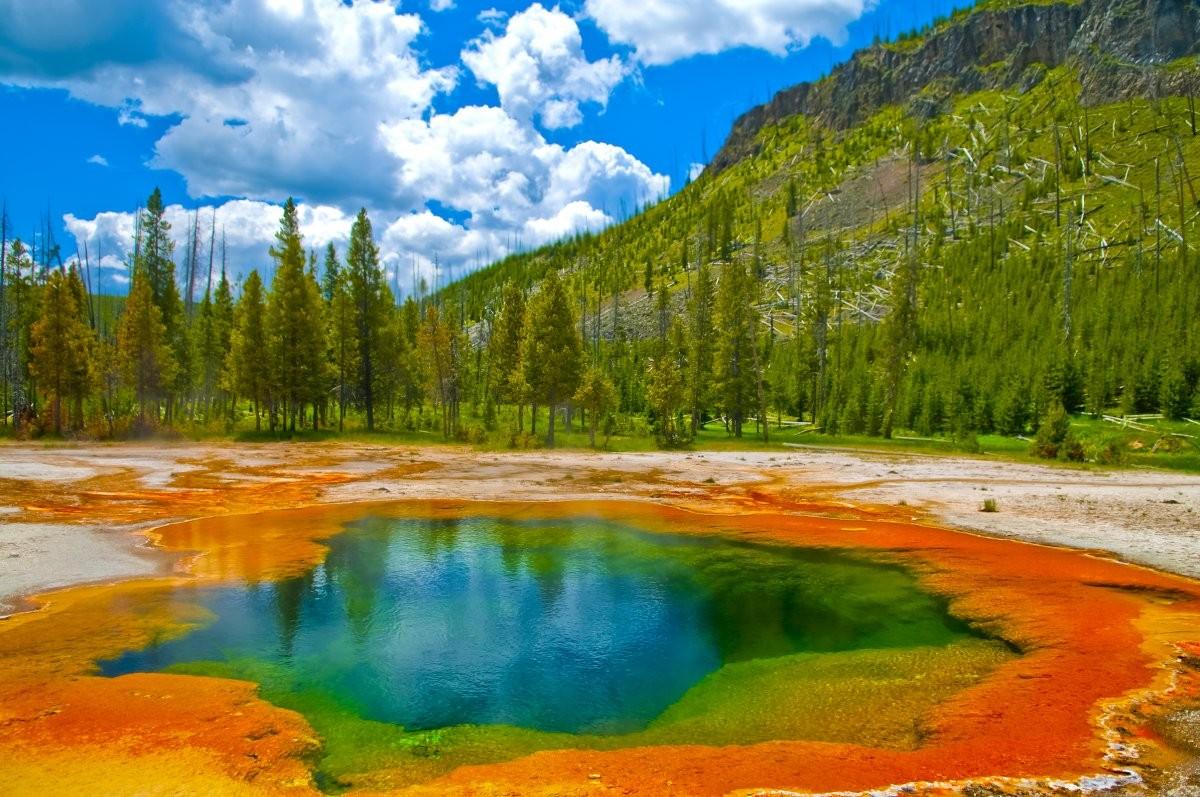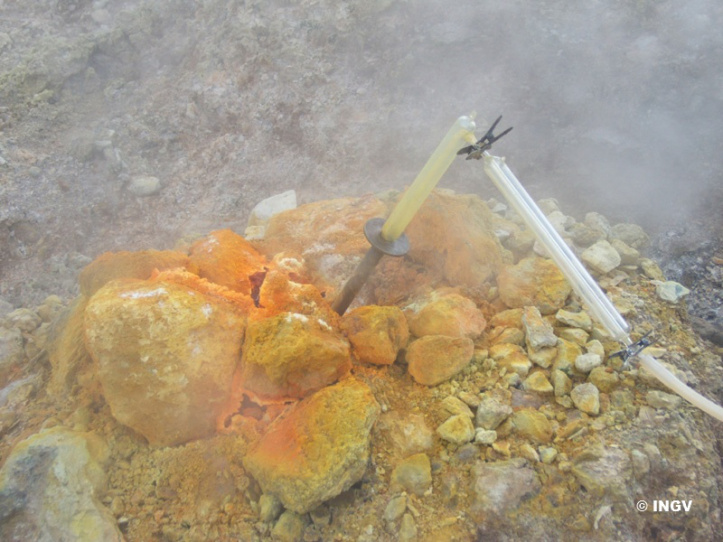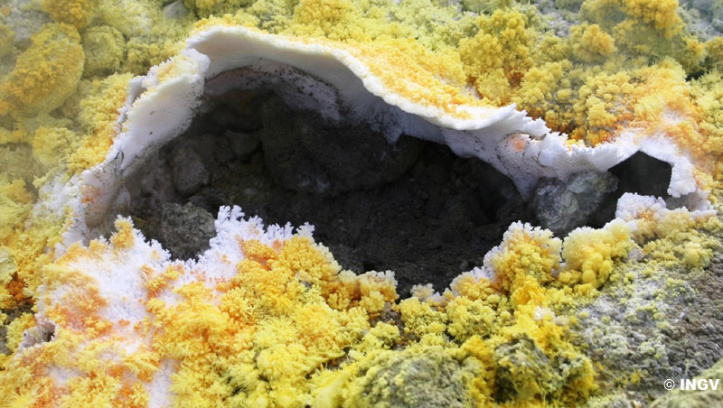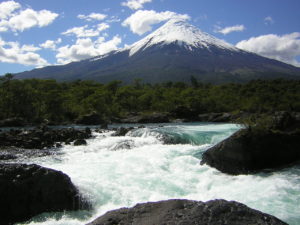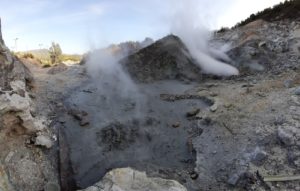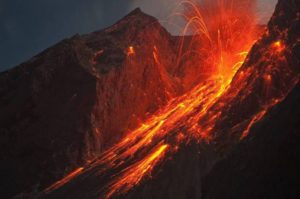August 02 , 2018.
Ecuador , Reventador :
Morphological changes on the Reventador volcano, April – June 2018.
Summary :
The El Reventador volcano has been active since 2002 and has exhibited significant morphological changes throughout its eruptive activity, particularly in recent months. During a surveillance flight conducted in June of this year, an escarpment was identified on the west flank of the volcano next to a new lava flow. However, the data obtained by the surveillance network, overflights and satellite information analyzed suggest that the main change would have occurred between April 15 and 27 of this year. This escarpment is the result of successive explosive events that could have produced emission columns with high ash content. This activity could have generated ash falls in the provinces of Napo and Pichincha between May and July.
Antecedents:
After the eruptive activity began in 2002, the top of the active cone was destroyed resulting in the formation of two new summits, East (3440 m) and West (3530 m) as well as two depressions formed on the northern flanks and South. Since then, the volcano has been characterized by having effusive and explosive activity, which allowed the continuous accumulation of volcanic material in the left crater in 2002. The preferential direction of its lava flows and pyroclastic flows was mainly towards the North and South, then Northeast, East and Southeast. Since 2012, eruptive activity has been explosive, allowing for greater generation and subsequent accumulation of pyroclastic materials at the top. This effect facilitated the generation of small to medium sized pyroclastic flows (<1.5 km in length). In 2017, there was a short but intense explosive activity and with it deposits of pyroclastic flows to the east flank, reaching a distance of about 3.5 km from the crater. These flows were the longest since those that were generated in 2002 that had gone down between 8 and 9 km.
Observations of recent activities:
Overview of April 26, 2018
During a flight over the volcano on April 26, the generation of a lava flow on the west flank was identified for the first time. It is assumed that this flow would have started to be emitted from April 12, from visual and thermal aerial observations. This stream was active at least 38 calendar days and reached a maximum distance of 3.8 km from the crater, Fig. 1. During this flight, it was not possible to observe the summit as it was completely cloudy.
Figure 1. Distribution of the lava flow generated in April (purple polygon) that would have been generated on the northwest flank of the volcano. In addition, the lava flow generated in June / July 2017 is observed and reaches 2.6 km (Source: IG-EPN).
Overview of June 20, 2018:
During the flight on June 20, 2018, an escarpment located between the summit and the west flank of the volcano was observed. Thanks to the analysis of the thermal images and the photographs, it was possible to observe the existence of three vents (Fig. 2, 3) which would have an explosive activity with at least the lower vent which presents an effusive activity with the generation of a small lava flow. It is assumed that its formation would have been generated between 15 and 27 April from satellite imagery (Sentinel 1), as shown in Figure 5. The possible collapse corresponds to what had already been mentioned in the Special Report No. 2, 2017 of the El Reventador volcano, which indicated a zone of weakness at the summit, which could become an unstable potential source capable of generating events such as the one mentioned above.
Fig. 2. Left: Photograph and thermal image of the west flank of the El Reventador volcano on April 12, 2018, showing that until that moment the volcano maintained its intact morphology. Right: Photo and thermal image of the same flank taken on June 20, 2018 showing the escarpment and the presence of three vents.
In addition, it has been possible to observe recent pyroclastic flow deposits that could have been generated by vent 3. In addition, at the base of this vent, the presence of a small flow of lava was observed descending to the west flank.
Throughout the overflight, the explosive activity was almost permanent from the vent 1. These explosions generated columns up to 1.5 km in altitude, with a high ash content.
This escarpment is the largest recorded since 2002 and would have a height difference of about 150 m between the highest point and the lowest point, with a maximum diameter of 550 m in the SE-WN direction (Figure 4) . Based on the analysis of the different types of instrumental data, observed field deposits, and satellite information, it is likely that the activity at the origin of the escarpment may be associated with several events that do not occur. were not of significant magnitude and would have developed between April 15 and 27, 2018.
Figure 3. Photo of the Northwest flank showing the escarpment that would have been generated by successive events between April 15th and 27th. There is also an explosion column generated by vent 1, pyroclastic flow deposits in the lower western flank and a small lava flow from vent 3. (Photo: S. Vallejo Vargas, IG -EPN).
Figure 4. Left: Map of El Reventador volcano showing the direction of a profile made in the NNW-SSE direction and the levels of the East and West peaks left in 2002. Right: NNW-SSE section showing the NNW-SSE profile of the volcano (black line) and current morphology (yellow zone) due to the activity recorded in April 2018 (Source: IG-EPN).
Figure 5. Left: Radar image of the Sentinel 1 satellite, taken on April 15, 2018. Right: Radar image of the Sentinel satellite 1 taken on April 27, 2018, in which the topographic change is clearly visible to the west of the crater of the cone active and this would indicate that it occurred before the April 27 image.
Conclusions:
It is important to consider that the volcano maintains high levels of internal and superficial activity.
The thermal recordings observed since April 2018 show permanent zones with thermal anomalies. This could correspond to zones of greater weakness in the volcano, likely to generate sectoral collapses and associated pyroclastic flows.
The possibility that an event of less magnitude or similar to those previously observed may occur on the volcano, generating pyroclastic flows and ash falls in the near and far parts, is not excluded. This last phenomenon in particular will depend mainly on parameters such as the amount of material generated and the direction of the wind.
Finally, it is important to mention that the current eruptive activity combined with the high slopes of the volcanic cone can generate sectoral avalanches from the top of the cone, as shown by those that occurred in June 2017 (Report of the work of the IGEPN on the El Reventador volcano, published in May / 2018).
Source : IGEPN , SV,FN,PR,MA,EG
Instituto Geofísico
Escuela Politécnica Nacional
Photos : J. L. Espinosa Naranjo , IGEPN.
United States , Yellowstone :
44°25’48 » N 110°40’12 » W,
Summit Elevation 9203 ft (2805 m)
Current Volcano Alert Level: NORMAL
Current Aviation Color Code: GREEN
Recent work and news
Steamboat geyser remained active in July, with eruptions on July 6 and 20. Some field work also took place in the Park, including geological mapping and the installation of a new gas monitoring array at Bison Flat near the Norris Geyser Basin. The gas sensors are designed to run year-round and are the first of their kind in Yellowstone. All other gas monitoring in the park consists of spot checks or temporary deployments that have never been continuous for more than a few months at a time. We are hopeful that this new data stream will provide insights into how gas concentrations vary according to seasonal (summer versus winter) and environmental (wind, rain, temperature, humidity, etc.) conditions.
Yellowstone Volcano Observatory scientists are also continuing to assist colleagues in Hawaiʻi with the response to the ongoing crisis at Kīlauea Volcano.
Seismicity
During July 2018, the University of Utah Seismograph Stations, responsible for the operation and analysis of the Yellowstone Seismic Network, located 153 earthquakes in the Yellowstone National Park region. The largest event was a micro earthquake of magnitude 2.5 on July 4 at 7:09 PM (MDT) and was part of a small sequence of 12 earthquakes located about eight miles east southeast of West Thumb, WY, and that occurred during July 2–10.
A larger sequence of 77 earthquakes occurred ~14 miles south-southwest of Mammoth, WY, during July 16–27. The largest earthquake of this swarm was a micro earthquake of magnitude 2.3 on July 24 at 8:40 PM (MDT).
Earthquake sequences like these are common and account for roughly 50% of the total seismicity in the Yellowstone region.
Yellowstone earthquake activity remains at background levels.
Ground deformation
Motion at nearly all GPS stations in Yellowstone was flat throughout July. During the first half of 2018, patterns of caldera subsidence and Norris uplift were steady, following trends that had been persistent since 2015. Since late June and through July, however, there has been no significant deformation recorded in the Norris and caldera areas. Whether this is a seasonal hiccup or a longer-term change remains to be seen. Similar pauses in deformation trends have occurred during previous summers, suggesting that seasonal changes, perhaps due to surface and subsurface water conditions, play a role in controlling Yellowstone deformation.
The Yellowstone Volcano Observatory (YVO) provides long-term monitoring of volcanic and earthquake activity in the Yellowstone National Park region.
Source : YVO.
Photos : USGS
Indonesia , Dukono :
VOLCANO OBSERVATORY NOTICE FOR AVIATION – VONA .
Issued: July 31 , 2018.
Volcano: Dukono (268010)
Current Aviation Colour Code: ORANGE
Previous Aviation Colour Code: orange
Source: Dukono Volcano Observatory
Notice Number: 2018DUK141
Volcano Location: N 01 deg 41 min 35 sec E 127 deg 53 min 38 sec
Area: North Maluku, Indonesia
Summit Elevation: 3933 FT (1229 M)
Volcanic Activity Summary:
Eruption with volcanic ash cloud at 22h05 UTC (07h05 local).
Volcanic Cloud Height:
Best estimate of ash-cloud top is around 20370.9FT (6173 FT (1929 M) M) above sea level, may be higher than what can be observed clearly. Source of height data: ground observer.
Other Volcanic Cloud Information:
Ash cloud moving to North-Northwest.
Remarks:
Eruption and ash emission is continuing.
Source : Magma Indonésie
Photo : S Chermette / 80 Jours voyages .
Hawai , Kilauea :
Wednesday, August 1, 2018, 12:29 PM HST (Wednesday, August 1, 2018, 22:29 UTC)
19°25’16 » N 155°17’13 » W,
Summit Elevation 4091 ft (1247 m)
Current Volcano Alert Level: WARNING
Current Aviation Color Code: ORANGE
Kīlauea Volcano Lower East Rift Zone
Fissure 8 continues to erupt lava into the channel leading northeastward from the vent. No overflows were reported this morning and lava levels in the more distant portions of the channel system appear low. At the coast, the south edge of the lava flow has not advanced westward in the past day, and remains less than 175 m (0.1 mi) from the Pohoiki boat ramp in Isaac Hale Park. Lava is actively entering the ocean along a broad 2 km (1.2 mi) flow front centered near the former Ahalanui Beach Park.
Aerial view to the southeast of the lava channel of crack 8. The overflows formed a lava pond in the meander of the fairway just west of the Kapoho crater (vegetated cone on the left).
No other fissures are active this morning.
Kīlauea Volcano Summit
Seismicity at Kilauea’s summit is back to 20-35 earthquakes per hour after the collapse event at 7:59 AM HST July 31 which was very similar to previous events.
Source : HVO
INGV Vulcani , the fuel of the eruptions:
Volcanic gas: the fuel of eruptions.
by Giorgio Capasso
The study of volcanic gases makes it possible to obtain very important information on the state of activity of a volcano. They are like telegrams sent by the magma to describe its conditions of temperature and pressure.
Figure 1 – Vulcano Island. High temperature fumarolic field at the edge of the crater « La Fossa »
Figure 2 – High temperature volcanic gas sampling system.
The gaseous emissions are always present during an eruption and are often the only visible manifestation of a volcano during quiescence. During an eruption, huge amounts of gas are emitted in the order of several thousand tons per day.
Volcanic gases are dissolved in the magma and among them the most important and also the most abundant is water (H2O). In addition to water, they consist of carbon dioxide (CO2), sulfur (SO2, H2S), hydrogen (H2), carbon monoxide (CO), methane (CH4), chlorine and fluorine (HCl, HF) in addition to very small amounts of rare gases such as helium (He), neon (Ne) and argon (Ar).
Near volcanic vents, the gases are responsible for deposits of sulfur, iron chloride and ammonium sublimates.
Figure 3 – Sublimated sulfur and ammonium chloride of a fumarole of the crater « La Fossa » (Vulcano Island)
Many metals such as iron, lead, tin, and gold have also been identified in sublimates, which is an important indication of how metals are transported through crustal rocks for subsequent focus on mineral deposits.
In general terms, an eruption can be considered as the transfer of thermal energy contained in the magma to the surface of the Earth. Thus, a volcano can be compared to a thermal machine that converts thermal energy into mechanics. Gases in general, but water in particular, allow this transformation of energy. Indeed, when a certain amount of water passes from the liquid state to the vapor state, it increases its volume by about 1000 times.
In addition, volcanic gases have played an important role in the geological evolution of the planet and probably in the birth of life on Earth. More and more established theories indicate that the Earth’s atmosphere and ocean water can be largely derived from the gases emitted by volcanic activity.
Source : Giorgio Capasso , https://ingvvulcani.wordpress.com/2018/07/30/i-gas-vulcanici/

